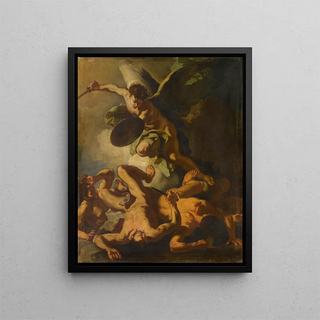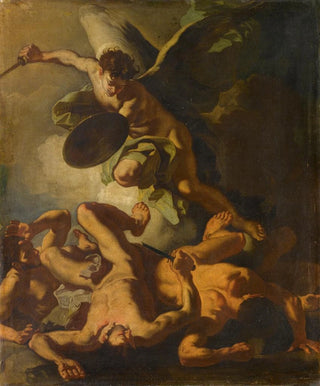Art print | Saint Michel chassant les anges rebelles - Francesco Solimena


View from behind

Frame (optional)
In the vibrant universe of baroque art, the artwork "Saint Michael casting out the rebellious angels" by Francesco Solimena stands out for its narrative power and spiritual depth. This painting, which depicts the celestial battle between good and evil, invites the viewer into an immersive world where light and shadow clash with striking intensity. Through this art print, the artist manages to capture the very essence of the divine struggle, offering a vision that is both dramatic and uplifting of Archangel Michael's victory over the forces of darkness. The scene, rich in detail and emotion, evokes a sense of grandeur and transcendence, making this piece a true baroque masterpiece.
Style and uniqueness of the artwork
Solimena's style is characterized by an exceptional mastery of movement and light, two elements that harmoniously combine in "Saint Michael casting out the rebellious angels." The dynamic composition, where figures seem almost to come alive under the viewer's gaze, demonstrates skill in capturing the decisive moment. The vibrant colors, especially the flashes of blue and gold, create a celestial atmosphere in the scene, while the expressions of the characters, both determined and terrified, enhance the dramatic intensity of the work. Every detail, from the majestic wings of the archangel to the faces of the cast-out angels, is carefully crafted, creating a visual harmony that transports the viewer to another time, another space, where the divine and human meet.
The artist and his influence
Francesco Solimena, an emblematic figure of Neapolitan baroque, knew how to leave his mark on his era with his unique style and his ability to evoke deep emotions through his works. Born in 1657, he was influenced by masters such as Caravaggio and Guido Reni, but developed a personal approach that is entirely his own. His work is not limited to simple depictions of religious scenes; he seeks to convey a spiritual experience, a connection with the sacred. This vision had a significant impact on his contemporaries

Matte finish

View from behind

Frame (optional)
In the vibrant universe of baroque art, the artwork "Saint Michael casting out the rebellious angels" by Francesco Solimena stands out for its narrative power and spiritual depth. This painting, which depicts the celestial battle between good and evil, invites the viewer into an immersive world where light and shadow clash with striking intensity. Through this art print, the artist manages to capture the very essence of the divine struggle, offering a vision that is both dramatic and uplifting of Archangel Michael's victory over the forces of darkness. The scene, rich in detail and emotion, evokes a sense of grandeur and transcendence, making this piece a true baroque masterpiece.
Style and uniqueness of the artwork
Solimena's style is characterized by an exceptional mastery of movement and light, two elements that harmoniously combine in "Saint Michael casting out the rebellious angels." The dynamic composition, where figures seem almost to come alive under the viewer's gaze, demonstrates skill in capturing the decisive moment. The vibrant colors, especially the flashes of blue and gold, create a celestial atmosphere in the scene, while the expressions of the characters, both determined and terrified, enhance the dramatic intensity of the work. Every detail, from the majestic wings of the archangel to the faces of the cast-out angels, is carefully crafted, creating a visual harmony that transports the viewer to another time, another space, where the divine and human meet.
The artist and his influence
Francesco Solimena, an emblematic figure of Neapolitan baroque, knew how to leave his mark on his era with his unique style and his ability to evoke deep emotions through his works. Born in 1657, he was influenced by masters such as Caravaggio and Guido Reni, but developed a personal approach that is entirely his own. His work is not limited to simple depictions of religious scenes; he seeks to convey a spiritual experience, a connection with the sacred. This vision had a significant impact on his contemporaries






